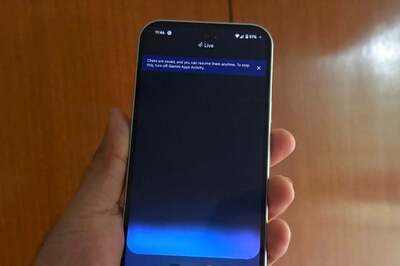
views
National Pension System (NPS) is a defined contribution pension system introduced by the Government of India as a part of Pension Sector reforms, with an objective to provide social security to all citizens of India.
NPS is administered and regulated by Pension Fund Regulatory and Development Authority (PFRDA).
A ‘Non-resident Indian’ (NRI) is allowed to open an account under the NPS.
NRI is a person resident outside India who is a citizen of India. These individuals hold an Indian passport and are eligible for various schemes announced by the government from time-to-time.
What is NPS?
The contributory pension system was notified by the Government of India in 2003, now named the NPS with effect from January 01, 2004. The NPS was subsequently extended to all citizens of the country w.e.f. May 01, 2009 including self employed professionals and others in the unorganised sector on a voluntary basis.
According to PFRDA, NPS is an easily accessible, low cost, tax-efficient, flexible and portable retirement savings account.
Also Read: NPS Latest Update: How PFRDA’s PAN-PRAN-VPA (UPI) Authentication Process Will Help You?
Under NPS, the individual contributes to her retirement account and her employer can also co-contribute for the social security/welfare of the individual.
NPS is designed on a Defined Contribution basis wherein the subscriber contributes to his/her pension account, there is no defined benefit that would be available at the time of exit from the system and the accumulated wealth depends on the contributions made and the income generated from investment of such wealth.
Under NPS, individual savings are pooled into a pension fund which are invested by PFRDA regulated professional fund managers as per the approved investment guidelines into the diversified portfolios comprising Government Bonds, Bills, Corporate Debentures and Shares. These contributions would grow and accumulate over the years, depending on the returns earned on the investment made.
How to open an NPS account?
Opening an account with NPS provides a Permanent Retirement Account Number (PRAN), which is a unique number and it remains with the subscriber throughout her lifetime.
The scheme is structured into two tiers:
Tier-I account: This is the non-withdrawable permanent retirement account into which the regular contributions made by the subscriber are credited and invested as per the portfolio/fund manager chosen of the subscriber. This is a permanent retirement account where under withdrawals up to 25% of the subscribers’ own contribution are permitted as per the Withdrawal and Exit Regulations.
Tier-II account: This is a voluntary withdrawable account which is allowed only when there is an active Tier I account in the name of the subscriber. The withdrawals are permitted from this account as per the needs of the subscriber as and when required.
Can an NRI join NPS?
Yes, an NRI between the age of 18 – 60 years, as on the date of submission of his/her application and complying with the extant KYC norms, can open an NPS account.
How to open an NPS account for NRI?
NRIs can open only Tier-I NPS accounts.
Can an NRI open a joint account in NPS?
No, only an individual account can be opened in NPS.
Is account operation with Power of Attorney (POA) allowed under NPS for NRIs?
At present, POA facility is not available in NPS.
Where will the funds contributed by NRIs in NPS be invested?
NRIs have the option to select Pension Fund Manager and exercise investment choice under NPS All Citizen Model. The fund is invested by the selected Pension Fund Manager in the various classes of securities, as per the investment guidelines prescribed by PFRDA.
The investment is usually in Equity, Corporate Bonds and /or Government Securities. The individual subscriber has a choice of selecting an investment mix, as per his/her risk appetite.
For NRIs, what would be the status of repatriation of the pension/ annuity and lump sum to be paid out of the invested funds ?
When the pension/ annuity is to be paid, it shall be in local currency only (i.e. in INR). However, there is no restriction on repatriation of pension, whether paid as annuity or in lump sum. Provisions of Income Tax Act, 1961 subject to amendments from time to time, would be applicable.
Will NRIs have different Exit & Withdrawal rules?
No, Exit & Withdrawal rules for NRIs shall be the same as for residents under the PFRDA (Exit and Withdrawals under the National Pension System) Regulations, 2015
What are the Exit rules applicable for NRIs?
The Exit rules applicable for NRIs are
-Upon attaining the age of 60 years
-Exit from NPS before the age of 60 years
-Upon Death of the Subscriber
How can NRIs open NPS accounts online?
NRIs having Aadhaar cards can open their NPS Account online.
Any individual can open a pension account under NPS through eNPS using either his Aadhaar Card or PAN card and Bank Account Verification.
Steps to open an NPS account online
Step 1
Go to PFRDA/ NPS Trust website and choose “eNPS”. Click on the “Registration” button and select the “New Registration” option to initiate the registration process.
Step 2
Select ‘Non Resident Indian (NRI)’ and Select type of account “Repatriable” or “Non Repatriable” and select option for registering with as “Aadhaar”.
Step 3
Enter Passport number and Aadhaar Number and click on Generate OTP. Now, Enter OTP received on the mobile number registered with Aadhaar and click on continue.
Step 4
For Repatriable eNPS A/c Select Bank from list of empaneled banks for Bank verifications and submit NRE/ NRO account details.
OR
For Non-Repatriable eNPS A/c Bank details of any bank a/c to be filled and submit NRE/ NRO account details on self declaration basis.
Step 5
Demographic details and photos will be fetched from the Aadhaar database and populated in online form.
Step 6
Fill up all rest of the mandatory details in different tabs.
As on September 24, 2022, total number of subscribers under NPS is 571.86 lakhs (5.72 crore) and total Assets Under Management (AUM) is 7,99,467 crore (7.99 trillion).
Read all the Latest Business News here



















Comments
0 comment